OTHER TOPICS
Cherry Blossoms at Nakayama Hokke Dera
Cherry Blossoms at Nakayama Hokke Dera at Nakayama, Ichikawa, Chiba Prefecture is one of the grand head temples
of Nichiren Sect Buddhism of Japan located at Nakayama, Ichikawa City,
Chiba Prefecture. The temple's history goes back to the 13th century when
Nichiren, the founder of the sect, spent peaceful days here during the
time when he had troubles with the Kamakura Government.
The temple also is the central training center of the Niichiren Sect Buddhism.
From November to February, the monks receive 100 days of severe practice
in cold weather. The buildings of the temple survived the Great Kanto Earthquake
and Air Raids of World War II and the visitors can enjoy beautiful old
Japanese temple buildings.
The temple is located very close to Higashiyama Kaii Memorial Hall. Visitors at the temple are recommended to call at the Higashiyama Kaii
Memorial Hall as well. Higashiyama Kaii is a renowned Japanese painter
(1908-1999) who lived in Nakayama, Ichikawa City.
Access: 5 minutes walk from Shimousa Nakayama Station on JR Sobu Line and
one minute walk from Keisei-Nakayama Station on Keisei Line.
Address: 2-10-1 Nakayama, Ichikawa City, Chiba Prefecture
Telephone: 047-334-3433 |
|
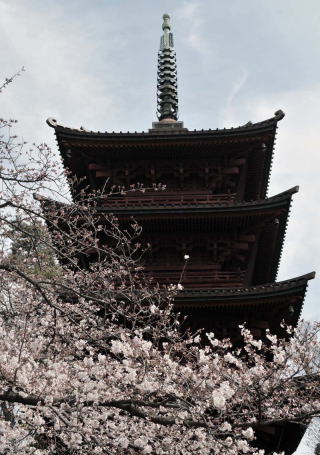 |
|
|
more photos |
Sunamachi Ginza Shopping Street
Sunamachi Ginza Shopping Street in Koto-ku is a traditional shopping street of Tokyo where people can
feel the nostalgic time of the Showa Era (1926-1989). It is located in
the area where trains do not run nearby. Instead, buses run frequently
to Kinshi-cho and other JR Sobu Line Stations such as Kameido, Ryogoku
etc. The shopping street is about 670 meters in length and about 160 shops
sell chiefly foods and almost all other daily necessities. The street was
called "okazu yokocho" before. Okazu meaning side dishes eating
along with rice. The place was before a town of family owned small factories
and working class people lived and live. The shopping street which was
once filled with huge shoppers of more 10,000 a day is overwhelmed by seven
super markets built within 4 kilo meters from the shopping street. Visitors
today decreased to about 3,000 a day (2017). At the same time, lack of
storekeeper successors is a big problem resulted from the aging Japanese
society. Shops without successors have been rented out and also Koreans
and other nationalities run some stores and restaurants today. Directors
of the Sunamachi Ginza Shopping Street hope for visits of inbound tourists.
Things sold here are cheaper than other places. Fresh and delicious "okazu"
foods are special and unavailable at supermarkets.
Shops Opening Time: 10 a.m.-6 p.m.
Access: Buses from Kinshicho Station on JR Sobu Line (get off at Kitasuna
2-chome bus stop)
Telephone: 03-3235-8031 (Mon-Sat, 9 a.m.-4 p.m.) |
|
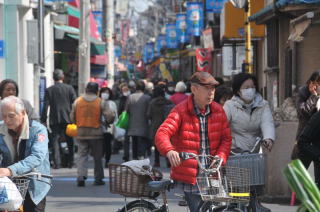 |
|
|
more photos |
TOKYO CHARACTER STREET
Tokyo Character Street which opened in 2005 in the basement of JR Tokyo Station is full of cute
Japanese animated characters such as "Pokemon, "Hello kitty,"
"Ghibli, "Rilakkuma" etc. All of them (21 shops) are official
shops of the characters. It also includes foreign characters such as Miffy
Style and Snoopy. If you love some Japanese characters, this is a perfect
place to go shopping and is a big fun just going around the shops.
URL: Tokyo Character Street
Address: 1-9-1 Marunouchi, Chiyoda-ku
Access: JR Tokyo Station Yaesu North Exit Basement Shopping District "Ichibankan"
Time: 10 a.m.-8:30 p.m. Seven days a week
Admission: free
Telephone: 03-3210-0077 |
|
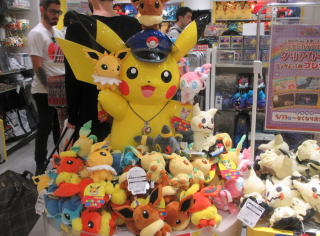 |
|
|
more photos |
NAKAYAMA HOKKE DERA
Nakayama Hokke Dera is one of the grand head temples of Nichiren Sect Buddhism of Japan located
at Nakayama, Ichikawa City, Chiba Prefecture. The temple's history goes
back to the 13th century when Nichiren, the founder of the sect, spent
peaceful days here during the time when he had troubles with the Kamakura
Government.
The temple also is the central training center of the Niichiren Sect Buddhism.
From November to February, the monks receive 100 days of severe practice
in cold weather. On Feb. 10 from 6 a.m. to 9 p.m. the cold-water purification
ceremony by monks will be open to the public at the temple. The buildings
of the temple survived the Great Kanto Earthquake and Air Raids of World
War II and the visitors can enjoy beautiful old Japanese temple buildings.
The temple is located very close to Higashiyama Kaii Memorial Hall. Visitors
at the temple are recommended to call at the Higashiyama Kaii Memorial
Hall as well. Higashiyama Kaii is a renowned Japanese painter (1908-1999)
who lived in Nakayama.
Access: 10 minutes walk from Shimousa Nakayama Station on JR Sobu Line
and one minute walk from Keisei-Nakayama Station on Keisei Line.
Address: 2-10-1 Nakayama, Ichikawa City, Chiba Prefecture
Telephone: 047-334-3433 |
|
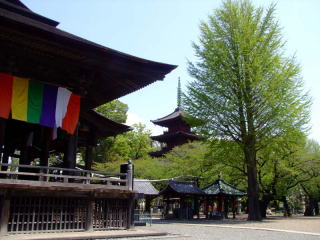 |
|
|
more photos |
TATEISHI
Tateishi is a neighborhood in Katsushika-ku on the eastern side of the Arakawa River locating on the edge of the metropolis Tokyo. The area is packed with nostalgic decrepit shopping streets. The area retains an atmosphere associated with Tokyo's shitamachi (commoners area) old-fashioned neighborhoods. Visitors here will fall into an illusion that they are back to the time and place some 50 years ago. Tateishi Nakamise, an old-fashioned shopping street near the railway Keisei-Tateishi station was started soon after World War II. At the market are sold cheap vegetables, grilled yakitori and squids, drinking houses etc. Until around 1980, Tateishi was home to numerous small, family-owned factories. Today many of these have closed and small apartment houses now occupy many of their former sites.
Access: Tateishi Station on Keisei Line from Ueno. |
|
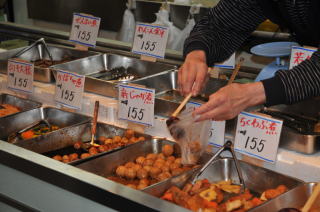 |
|
|
more photos |
TATEISHI - KATSUSHIKA TRADITIONAL CRAFTS
Katsushika Traditional Crafts Building
In Katsushika-ku, there still exist many craftsmen succeeding the traditional skills since the time of Edo era and Meiji period. They examine natural materials closely with the inherited perceptions cultivated by longtime practices and produce traditional industrial art objects making full use of the traditional skills for the present and the future. At the hall, traditional crafts produced in Katsushika-ku are displayed and sold on the spot.
Website: http://www.dentosangyokan.com/
Open: 11 a.m.-6 p.m. (closed Mon. and Tue.)
Admission: free
Address: 7-3-16 Tateishi, Katsushika-ku
Access: 5 minutes walk from Tateishi Station on Keisei Line
Telephone: 03-5671-8288 |
|
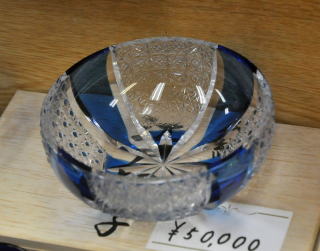 |
|
|
more photos |
JINDAI BOTANICAL GARDENS AND JINDAIJI TEMPLE
Roses at Jindai Botanical Gardens and Jindaiji Temple in Chofu City
This is the only metropolitan botanical garden in Tokyo which opened in
1961. About 100,000 trees and brushes of 4,500 species are planted in the
space of 12,063 acres. The gardens, reminiscent of the Musashino region,
provide a place to enjoy beautiful trees, grasses and flowers in all seasons.
The rose garden of Jindai Botanical Gardens is famous and many people visit
the garden in May.
URL: Jindai Botanical Gardens
Hours: 9:30 a.m.-5 p.m. (closed Monday if Monday is a holiday on Tuesday. Yearend holidays Dec. 29-Jan. 1)
Admission: 500 yen
Address: 5-31-10 Motomachi, Jindaiji, Chofu City
Access: Jindai-shokubutsu-koen-mae bus stop on Keio Bus for Kichijoji or
Mitaka from Chofu Station on Keio Line
Telephone: 042-483-2300 |
|
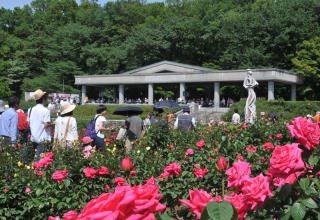 |
|
|
more photos |
JR TOKYO STATION
|
JR Tokyo Station's renewed Marunouchi-side red brick building officially opens
The magnificent three-story, 330 meters wide, 9,545 square meter classical
building officially opened on Oct. 1, 2012. The original Tokyo Station
was built in 1914 designed by Kingo Tatsuno. The building endured the Great
Kanto Earthquake in 1923, but the 3rd floor and the domes on the north
and south wings were destroyed by air raids in 1945.
During 1980's, the railway company planned to replace the red-brick building
with a modern high-rise building but Tokyo citizens campaigned to preserve
the classical building and it was listened and the Tokyo Station building
was restored in the style of its original style.
Half of its floor space is used as a hotel.
|
|
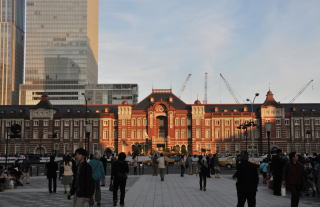 |
|
|
more photos |
SNOW IN TOKYO
Tokyo is located at 35.41N in latitude and is a little more to south than
Athens in Greece and approximately the same as Tunis in Northern Africa,
and midway between San Francisco at 38N and Los Angeles at 33N. Hence,
snow is a rare thing in Tokyo. It snows only a couple of days a year. But
if it snows, it often paralizes the metropolitan area transportation systems.
Average temperatures in Tokyo were 6.8C (44.24F) in January and 7.8C (46.04F)
in February in 2008.
The temperatures in Tokyo often go below zero in Centigrade (32 in Fahrenheit)
and a strong seasonal dry wind from the continent is very cold.
.
The pictures were taken at Ueno Park and Asakusa on February 3 in 2008. |
|
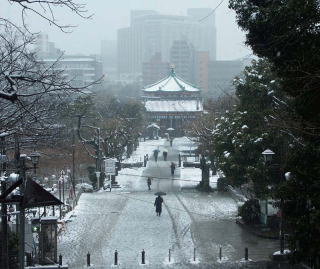 |
|
|
more photos |
RYUKOZAN at TATSUNOKUCHI (ENOSHIMA)
Ryuko-ji Temple was built on the spot where the prophet and reformist Nichiren (1222-1282), founder of the Buddhist sect "Nichiren-shu," was
nearly beadeded in September, 1271 for his persistent denunciations of
the politicians and the great Buddhism sects of the time Jodo, Shingon
and others.
His
aggressive behavior was already in bad odour with the authorities. Unstopping
his harsh criticism and arming of his followers finally led to his arrest and
the government decided to exile him to Sado island. However, Hei-no Yoritsuna
planned secretly to execute Nichiren and arrested him. He was taken to the
execution grounds at Tatsunokuchi on the night of Sept. 12. Legend tells, at the
moment when Nichiren was to be beheaded, an object shining like the moon at the
edge of Enoshima Island flew across the sky like a bolt of lightning and
split the blade in two, just in time for the shogun's messenger to arirve
with a reprieve.
Address: 3-13-37 Katase, Fujisawa City, Kanagawa
Prefecture.
Access: 10 minutes walk from either Koshigoe Station or Enoshima
Station on Enoshima Dentetsu Railway.
Telephone: 0466-25-7357 |
|
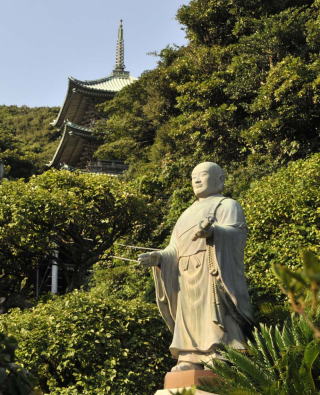 |
|
|
more photos |
AOYAMA-HARAJUKU-OMOTE SANDO
Aoyama, Harajuku and Omote Sando areas are known as one of the most fashionable districts of Tokyo.
Along the Aoyama Street which runs from Shibuya to Akasaka are the high
volumes of brand shops and restaurants making it one of the famous shopping
streets of Tokyo.
At Omote Sando boutiques of international brands and bistros stand side
by side. Some compare the town to the Champs-Elysees in Paris. The boulevard
Omote Sando leading to the Tokyo's finest shrine Meiji Jingu is a very
pleasant area to stroll.
There also is an area for youngsters closer to JR Harajuku Station. At Takeshita Dori (Takeshita Street), the narrow streets are lined by many trendy shops, fashion boutiques, used clothes, crepe stands and fast food outlets.
Access: Harajuku Station on JR Yamanote Line, Omote Sando Station on Subways
Chiyoda Line, Ginza Line and Hanzomon Line. |
|
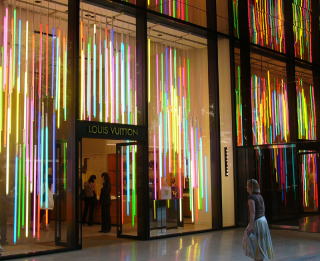 |
|
|
more photos |
TSUKIJI FISH MARKET
Tsukiji Fish Market has recently become "world famous" thanks to increased foreign visitors to this Japan's and world's largest wholesale fish and seafood market.
The market opens at 5 a.m. and closes at 11 a.m. Exciting daily tuna auction
sales and transactions begin at 5 a.m. and from 7 a.m. wholesalers begin
displaying the fishes they purchased in early morning auctions in their
shops which are inside the market building. From 8 a.m. fish shoppers and
restauranteurs come to buy up the day's catch. In the afternoon, the market
becomes very quiet and cleaning of the compound begins in preparation for
tomorrow deals while wholesalers are still busy in contacting their customers
over telephones.
The market in avarage deals 2,070 tons and 480 kinds of fishes daily.
Depending on their qualilty, each tuna sells between 600,000 yen to one
million yen.
Address: 5-2-1 Tsukiji, Chuo-ku
Access: Tsukiji Station on Subway Hibiya Line
The market is usually closed on Sundays and Wednesdays and on national
holidays.
Visitors are allowed to view tuna auction from 5 a.m. to 6:15 a.m.
Telephone: 03-3547-8011 (Tokyo Metropolitan Government Tsukiji Fish Market
Office) |
|
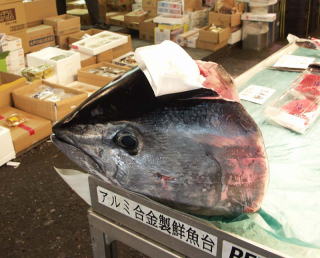 |
|
|
more photos |
SOJIJI TEMPLE
Sojiji temple at Tsurumi, Yokohama is one of the two main temples of Soto Sect
Zen Buddhism in Japan while the other being Eiheiji temple in Fukui Prefecture.
The temple was originally founded in 1321 by Keizan Jokin in Noto Province now in Ishikawa Prefecture which is not very far from the other main Soto Sect Zen buddhism temple Eiheiji.
Sojiji was moved in 1911 to the present location in Tsurumi in the city of Yokohama after a fire had destroyed it some years earlier. By moving the center to Tsurumi a remote place of Kanto district, the sect intended to propagate the Soto sect of Zen buddhism to all regions of Japan. Today, Sojiji in Tsurumi is one of the largest and most active Buddhist institutions in the eastern part of Japan.
Address: 2-1-1 Tsurumi, Tsurumi-ku, Yokohama City, Kanagawa Prefecture
Access: Tsurumi Station on JR Keihin Tohoku Line
Telephone: 045-581-6021
|
|
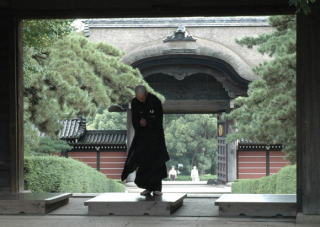 |
|
|
more photos |
YUSHIMA SEIDO (Confucian Sacred Hall)
Yushima Seido (Confucian Sacred Hall) has its origins in a private Confucian hall built by the famous Edo period
Confucian scholar Hayashi Razan (1583-1657) in his grounds in Shinobugaoka
in Ueno.
Hayashi Razan had a Confucian school and library there under the patronage
of the third shogun Tokugawa Iemitsu.
In 1691 the school was moved to the present site of Yushima where the
fifth shogun, Tokugawa Tsunayoshi , donated some property and the site
was given the title Shoheizaka Gakumonjo (Academy). Thus the school was
given official status by the Tokugawa shogunate which adopted Confucian
teachings and philosphy as back bones of the government. During the time
of Tokugawa period, many talented men studied here. After the Meiji Restoration
of 1868, the school was taken over by the Meiji government but was discontinued
in 1871.
The bronze statue of Confucious was donated by the Lion's Club in Taipei
in 1975.
Admission: Free
Open 9:30 a.m. - 5 p.m. (4 in winter)
Main Hall was open only on Saturday and Sunday.
Closed Aug. 13 through 17 in summer and Dec. 29 through 31 in the year-end
Address: 1-4-25 Yushima, Bunkyo-ku
Access: Ochanomizu Station on JR Chuo-Sobu Line, Ochanomizu Station on
Subway Marunouchi Line and Shin Ochanomizu Station on Subway Chiyoda Line.
Telephone: 03-3251-4506 (Shibunkai) |
|
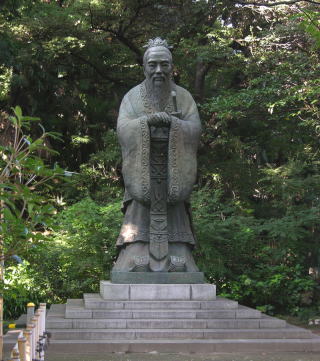 |
|
|
more photos |
TOGE-NUKI JIZO
Toge-nuki Jizo (the splinter-removing Ksitigarbha) in Sugamo, Toshima-ku.
The official name of Togenuki Jizo is Kogan-ji. The temple is popularly
known as Togenuki Jizo. The legend says the wife of a samurai named Tamura
was very ill. Her husband prayed to Jizo for her recovery. Jizo appeared
to him in a dream and told him to make Jizo pictures and float them on
a river. In the next morning, he was surprised to find by his pillow a
strangely shaped block of wood on the surface of which was carved a faint
picture of Jizo. He printed 10,000 impressions of Jizo and when he took
the sheets and threw them into the Sumida River, as directed his dream,
his wife was completely cured. The samurai donated the sacred block of
wood with the pictures of Jizo to Koganji Temple. This story spread quickly
throughout the city of Edo and since then, the temple has come to attract
many visitors who pray for cure of all kinds of illness.
The grand festivals of Koganji Temple are held on Jan. 24, May 24 and Sept.
24.
Every month on the 4th, 14th and 24th, fairs are held along the street
leading to the temple. The temple and the shopping street are crowded with
old folks.
Address: 3-35-2 Sugamo, Toshima-ku
Access: Sugamo Station on JR Yamanote Line and Subway Toei Mita Line
Telephone: 03-3917-8221 |
|
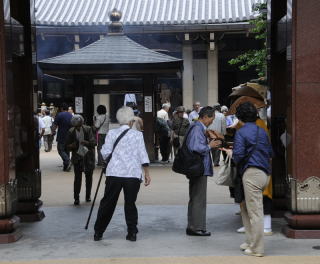 |
|
|
more photos |
YUMENOSHIMA TROPICAL GREENHOUSE
Yume-no-Shima Tropical Greenhouse Dome was built on the former landfill place of Tokyo Bay in 1988 by the Tokyo
Metropolitan Government. Huge energy which is necessary for heating the
greenhouse is supplied by high temperature water coming from the adjacent
Koto Incineration plant which burns garbages gathered from the eastern
part of Tokyo.
More than 1,000 kinds of tropical plants from Africa, South America, South
Asia, etc. are housed in the dome which temperature is controlled at 20
to 23 centigrade (69-74 fahrenheit) throughout the year.
Open: 9:30 a.m.-4 p.m. Closed: Monday (if Monday falls on holiday, it is
open on Monday and closed on Tuesday), Also closed from Dec.29 through
Jan. 3.
Admission: 250 yen (adult), 100 yen J.H. Students and 120 yen for people
of 65 and above.
Access: Shinkiba Station on Rinkai Line.
Telephone: 03-3522-0281
|
|
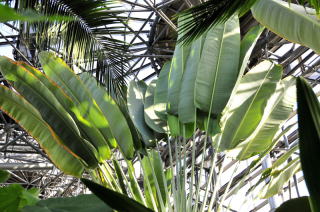 |
|
|
more photos |
Return to top of this page















